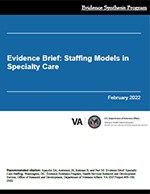
Recommended Citation:
Apaydin EA, Anderson JA, Rahman B, and Parr NJ. Evidence Brief: Specialty Care Staffing. Washington, DC: Evidence Synthesis Program, Health Services Research and Development Service, Office of Research and Development, Department of Veterans Affairs. VA ESP Project #09-199; 2022.
Download PDF: Brief, Supplemental Materials
Outpatient specialty care staffing models and interventions, including addition of new staff or use of existing staff, may be related to lower utilization, higher access, improved outcomes, reduced costs, and high patient/provider and staff satisfaction, but evidence is limited by study design, minimal information on patient populations, and a lack of statistical analyses. It is unclear whether the addition of new clinics to support existing clinics is associated with improvement in productivity or patient-important outcomes.
Staffing models and interventions in outpatient specialty care have the potential to increase productivity and improve patient-important outcomes by ensuring that staff who can complete tasks in a clinic or organization are almost always available. By improving staffing models or employing staffing interventions, managers can ensure that inefficiencies are minimized in a clinical workflow and that more highly trained clinicians and staff are working to the full extent of their expertise and licensure.
The addition of new or the use of specific types (ie, advanced practice nurses) of existing specialty care staff in outpatient specialty care may be related to lower utilization, higher access, improved outcomes, reduced costs, and high patient/provider and staff satisfaction. Our confidence in these findings is low due to limitations in study design (ie, lack of comparison groups), lack of information on patient populations, and a lack of statistical analyses. It is unclear whether the addition of new clinics to support existing specialty care clinics is associated with improvement in productivity or patient-important outcomes. Contextual characteristics could not be directly compared across studies, but high or positive patient, provider, and staff satisfaction were consistently associated with the evaluated staffing models/interventions across specialties. Future research could be more rigorous, designed to assess how staffing affects productivity and patient-important outcomes, and better directed by a conceptual model of outpatient specialty care.